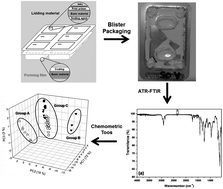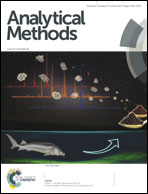Viagra® and Cialis® blister packaging fingerprinting using Fourier transform infrared spectroscopy (FTIR) allied with chemometric methods
Abstract
The production of counterfeit drugs is a criminal problem that carries serious risks to public health worldwide. Herein, the chemical fingerprinting of blister packaging using Fourier transform infrared spectroscopy (FTIR) of authentic and counterfeit samples of Viagra® and Cialis® is demonstrated. Fifteen commercial samples (Viagra® and Cialis®) and thirty two counterfeit samples (Viagra and Cialis) were analyzed, and the FTIR data was subjected to chemometric treatment via unsupervised pattern recognition methods (principal component analysis, and hierarchical cluster analysis) and a supervised pattern recognition method (partial least squares discriminant analysis). ATR-FTIR spectra of the blister packaging of authentic Cialis® and counterfeit Cialis samples showed bands at 2976, 2904, 1431, 1326, 1243, 973, 691 and 608 cm−1, suggesting the presence of polyvinyl chloride (PVC) in its chemical composition. For authentic Viagra® and counterfeit Viagra samples, several distinct chemical profiles were observed in the ATR-FTIR spectra. Using unsupervised methods, samples were separated into three large groups: (i) counterfeit Viagra (seven samples made of PVC); (ii) authentic Viagra® (three samples made of poly(ethylene terephthalate)); (iii) Cialis (authentic and counterfeit) and some samples of Viagra (thirty seven made of PVC with additives of stearic acid derivatives, butyl hydroxy toluene or bisphenol A). Therefore, this suggests that three different types of forming films are used in the market for blister packaging used to contain inhibitors of PDE-5. Using supervised methods, all samples were correctly classified into their respective classes.


 Please wait while we load your content...
Please wait while we load your content...